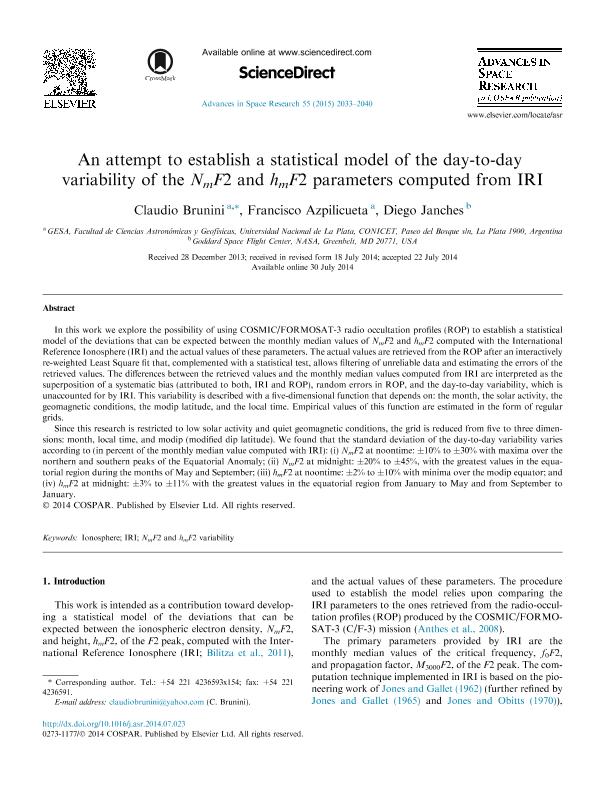Mostrar el registro sencillo del ítem
dc.contributor.author
Brunini, Claudio Antonio

dc.contributor.author
Azpilicueta, Francisco Javier

dc.contributor.author
Janches, Diego
dc.date.available
2017-06-12T15:28:14Z
dc.date.issued
2015-04
dc.identifier.citation
Brunini, Claudio Antonio; Azpilicueta, Francisco Javier; Janches, Diego; An attempt to establish a statistical model of the day-to-day variability of the NmF2 and hmF2 parameters computed from IRI; Elsevier; Advances In Space Research; 55; 8; 4-2015; 2033-2040
dc.identifier.issn
0273-1177
dc.identifier.uri
http://hdl.handle.net/11336/17968
dc.description.abstract
In this work we explore the possibility of using COSMIC/FORMOSAT-3 radio occultation profiles (ROP) to establish a statistical model of the deviations that can be expected between the monthly median values of NmF2 and hmF2 computed with the International Reference Ionosphere (IRI) and the actual values of these parameters. The actual values are retrieved from the ROP after an interactively re-weighted Least Square fit that, complemented with a statistical test, allows filtering of unreliable data and estimating the errors of the retrieved values. The differences between the retrieved values and the monthly median values computed from IRI are interpreted as the superposition of a systematic bias (attributed to both, IRI and ROP), random errors in ROP, and the day-to-day variability, which is unaccounted for by IRI. This variability is described with a five-dimensional function that depends on: the month, the solar activity, the geomagnetic conditions, the modip latitude, and the local time. Empirical values of this function are estimated in the form of regular grids. Since this research is restricted to low solar activity and quiet geomagnetic conditions, the grid is reduced from five to three dimensions: month, local time, and modip (modified dip latitude). We found that the standard deviation of the day-to-day variability varies according to (in percent of the monthly median value computed with IRI): (i) NmF2 at noontime: ±10% to ±30% with maxima over the northern and southern peaks of the Equatorial Anomaly; (ii) NmF2 at midnight: ±20% to ±45%, with the greatest values in the equatorial region during the months of May and September; (iii) hmF2 at noontime: ±2% to ±10% with minima over the modip equator; and (iv) hmF2 at midnight: ±3% to ±11% with the greatest values in the equatorial region from January to May and from September to January.
dc.format
application/pdf
dc.language.iso
eng
dc.publisher
Elsevier

dc.rights
info:eu-repo/semantics/openAccess
dc.rights.uri
https://creativecommons.org/licenses/by-nc-sa/2.5/ar/
dc.subject
Ionosphere
dc.subject
Iri
dc.subject
Nmf2 And Hmf2 Variability
dc.subject.classification
Investigación Climatológica

dc.subject.classification
Ciencias de la Tierra y relacionadas con el Medio Ambiente

dc.subject.classification
CIENCIAS NATURALES Y EXACTAS

dc.title
An attempt to establish a statistical model of the day-to-day variability of the NmF2 and hmF2 parameters computed from IRI
dc.type
info:eu-repo/semantics/article
dc.type
info:ar-repo/semantics/artículo
dc.type
info:eu-repo/semantics/publishedVersion
dc.date.updated
2017-05-08T17:16:16Z
dc.journal.volume
55
dc.journal.number
8
dc.journal.pagination
2033-2040
dc.journal.pais
Países Bajos

dc.journal.ciudad
Amsterdam
dc.description.fil
Fil: Brunini, Claudio Antonio. Universidad Nacional de la Plata. Facultad de Ciencias Astronómicas y Geofísicas; Argentina. Consejo Nacional de Investigaciones Científicas y Técnicas; Argentina
dc.description.fil
Fil: Azpilicueta, Francisco Javier. Universidad Nacional de la Plata. Facultad de Ciencias Astronómicas y Geofísicas; Argentina. Consejo Nacional de Investigaciones Científicas y Técnicas; Argentina
dc.description.fil
Fil: Janches, Diego. Nasa Goddard Space Flight Center; Estados Unidos
dc.journal.title
Advances In Space Research

dc.relation.alternativeid
info:eu-repo/semantics/altIdentifier/url/http://www.sciencedirect.com/science/article/pii/S0273117714004797
dc.relation.alternativeid
info:eu-repo/semantics/altIdentifier/doi/http://dx.doi.org/10.1016/j.asr.2014.07.023
Archivos asociados
